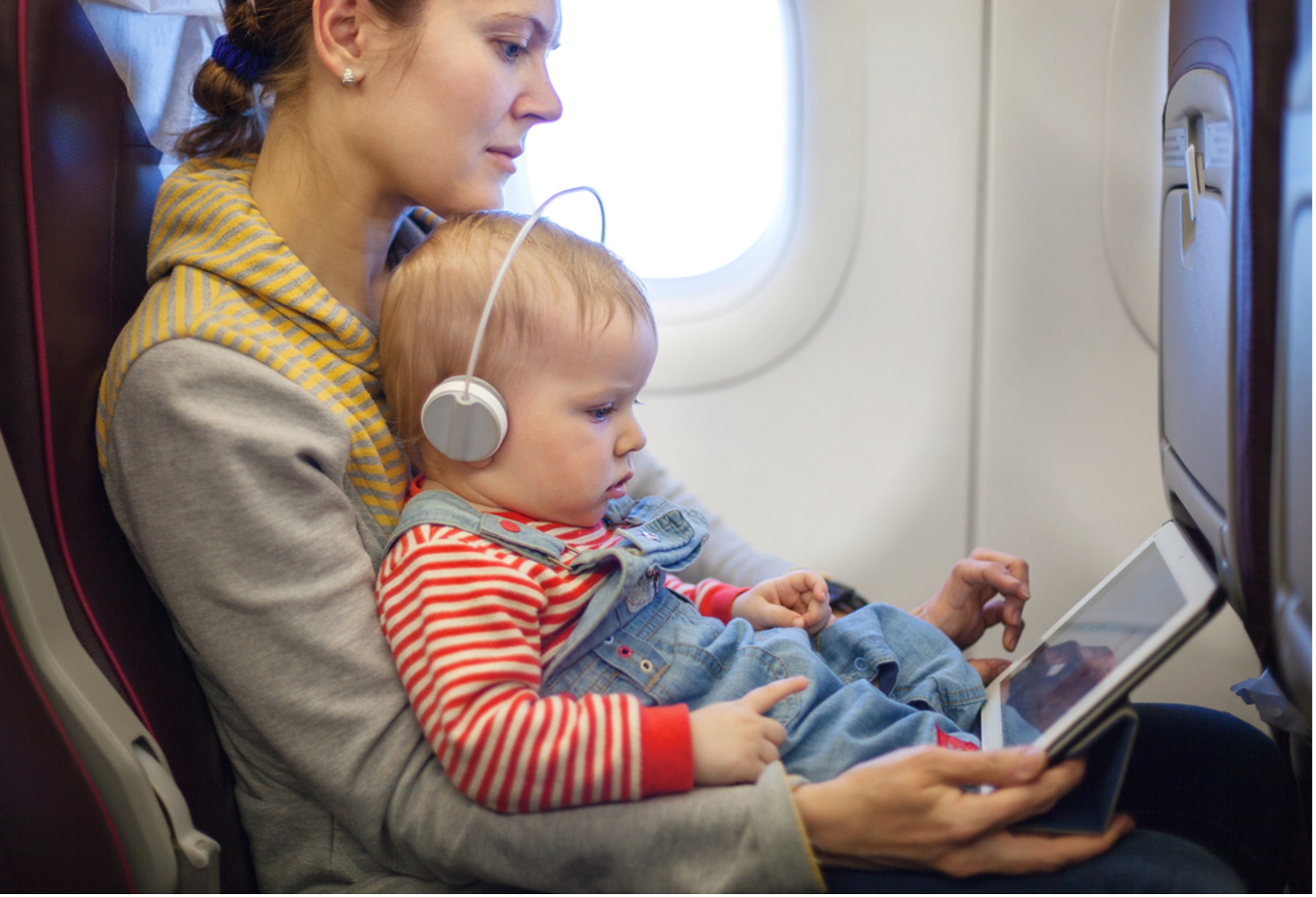Cost savings versus risks to safety and sanity—here’s what to consider.

One of the ways families save money on domestic air travel with small children is by having a child fly as a “lap infant.” There is debate about the safety of this practice, but some parents appreciate the savings, and small children often just want to be in their parent’s arms anyway.
Here’s what you need to know regarding lap infants, along with tips to make flying with a baby easier.
Lap infant rules
- “Under two”
To qualify as a lap infant, your child must be under two years old. The day they turn two, that free ticket is GONE: If you have a trip that spans your child’s second birthday, only the outbound flight will be free. On the return flight, you will be required to purchase your now-two-year-old a seat with a one-way ticket. (The exception: British Airways will give you the return seat at the same infant fare if your child turns two during the journey.)
Be aware there are times when buying a one-way flight can be more costly than a round trip, so price out both options if your child is going to turn two during your trip.
- Empty seats and lap infants
Can your lap infant snag a free empty seat? Yes! If there is an unoccupied seat next to you, you just scored a seat for your child without having to pay for it. It’s a good idea to speak to the gate agents before boarding to ask if a passenger is sitting next to you. If the flight isn’t full, they might help you find a new seat assignment with an empty seat beside it.
If you think there might be an empty seat next to you and have an FAA-approved car seat (FAA-approved car seats usually have a sticker saying so on the side), bring the seat to the gate. If you don’t get access to an empty seat to use it, you can always gate-check the car seat for no fee, and it will be waiting for you when you land.
- Luggage allowance for lap infants
Infants flying on paid tickets get the same baggage allowance as adults on paid tickets, but that’s not the case when your under-2-year-old is flying for free on your lap. Children not occupying a paid seat are not given a checked baggage allowance on most U.S. domestic airlines. Their luggage will be checked with the child’s parents’ luggage and will be subject to any extra baggage fees charged by the airline.
Fortunately, families can check car seats, usually without an added cost. Also, strollers can come on board or be gate-checked, depending on size, for no additional fee; they won’t count against your baggage allowance regardless of whether your child is flying as a lap infant or on a paid fare.
For carry-on bags, most airlines will allow you to bring a diaper bag on board in addition to the airline’s regular carry-on allowance. (Note that Alaska Airlines does not extend this generous diaper-bag policy to lap infants.)
The various luggage requirements are why Southwest Airlines is such a favorite airline among families, as all passengers flying on paid tickets get to check two complimentary bags per person.
- Traveling with more than one lap infant
The strict rule is one lap infant per adult. If you are flying as a solo adult and have two or more children under the age of 2 with you, you must purchase a ticket for one of them (and you should also be awarded a gold medal at the other end of the journey). Two adults traveling together (or even an older teen with an adult) can have two lap children with them. Don’t be surprised, however, if the flight attendant tells you that you cannot sit next to each other. Because of the limited number of oxygen masks, most aircraft only permit one lap infant per row. Lap infants are also not allowed in emergency exit rows or the rows directly in front of or behind the exit rows. On some aircraft, there are additional rows that do not permit lap infants. If you’re flying with an infant and the aircraft includes bassinets, book that row if you can. Typically, you’ll find bassinets on international flights, but they might also be available on domestic flights with internationally configured aircraft.
- Lap infant fares on international flights
Most international flights allow children under 2 to fly as lap children, but it’s usually not 100% free. Typically, if you’re flying on a revenue ticket, you must pay the taxes and fees for your lap infant plus, in most cases, 10% of the fare. That might not sound like a lot, but it can add up. Remember, ticket prices fluctuate, so be mindful of when you add your child as a lap infant.
If you are traveling with a lap infant to somewhere relatively close, like Mexico or the Caribbean, consider JetBlue, Southwest, or Alaska. Those airlines don’t charge a percentage of the adult fare for lap infants flying internationally, just taxes.
Tips for flying with a baby
- Bring identification.
Technically, most airlines require you to show proof of age for your lap infant. This can include a birth certificate, passport, or sometimes hospital or immunization records. In reality, most airlines will not ask you for that information unless your baby looks like a toddler who could be past that second birthday. If you plan to travel internationally after your baby is born, you’ll have to get your child a passport.
If you arrive at the airport counter without any documentation for your baby, airlines can theoretically require you to purchase a regular seat for your child. Not only can same-day flights be quite expensive, but you also risk the chance of the flight being sold out.
Southwest is notorious for asking for proof of age for everyone, even newborns, so don’t forget your documentation! (Note: Stash a copy in your luggage or save a picture on your phone as a backup.)
- Time flights with your baby’s sleep patterns.
Babies sleep a lot, just not always when you want them to. Try to book flights coinciding with their sleep schedules. For longer flights, if you can choose a flight that’s close to their bedtime or an overnight red-eye, you may have a better chance of getting them to sleep for a large part of the journey. For shorter day flights, try to time the flight to your baby’s customary nap time. All that said, an overtired baby can resist falling asleep, especially in a strange environment. You know your baby best, so if you think there’s no shot of them sleeping on a plane through the night, there’s nothing wrong with just going for that daytime flight as rested and prepared as possible.
- Change diapers before boarding.
It’s no fun trying to change a diaper in a cramped airplane bathroom, and there’s also the possibility of being delayed on the tarmac. So do a quick diaper change before boarding to potentially reduce the number of changes you’ll have to do in flight.
- Feed during takeoff and landing.
Know how your ears pop on the plane, and you yawn or chew to make the sensation go away? Well, babies haven’t mastered the art of equalizing their ear pressure, so takeoff and landing can be particularly uncomfortable for them. Feeding during this time can help relieve this pressure because the sucking motion they make will help equalize their ears.
- Pack extra earplugs.
Sometimes no matter what you do, a baby will cry on a plane. You can help make it a little less painful for those around you by bringing and handing out extra earplugs. Sometimes parents choose to distribute small goodie bags as a friendly gesture toward other passengers in the hope of gaining sympathy and understanding. You don’t have to do this, but it’s an option that may make you less anxious about the trip.
- Figure out seating arrangements beforehand.
Before you board, it’s important to figure out the best way for your baby to sit. Consider how your child is most comfortable: Do they prefer to snuggle up to a human or are they more relaxed in a car seat? (If the latter, you’ll need to book an airplane seat for your child if you want to guarantee that the child will be in a car seat beside you.)
Minimum age to fly
The minimum age to fly varies by airline. Some theoretically allow you to fly the same day the baby is born, while others require the baby to be at least a week or two old. Some airlines will also require a doctor’s note giving the go-ahead to young flyers. Aside from the actual requirements set by the airplane or your doctor, how young is actually too young to fly? While there are times when flying with newborn babies simply can’t be avoided, such as after an adoption, to visit family, or for work reasons, many pediatricians recommend waiting until a baby is at least two to three months old because they are vaccinated by this time and thus might be more resistant to infections.
Twist’s Take: Lap infants under two fly for free—just be sure the loss of safety (and sanity) are worth the cost savings.
